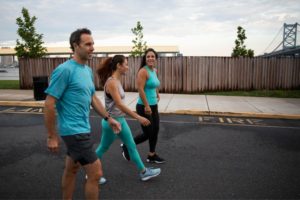Walking is a quick and efficient workout for our general health and well-being.
But many people neglect to use their glutes, the powerful buttocks muscles while walking.

This may result in a lack of muscular activation, lousy posture, and even lower back and leg pain discomfort.
Posture correction, longer strides, and lifting weights are a few strategies to help you activate your glutes while you walk.
In addition, including hills or stairs in your walking schedule can aid in glute activation.
In this article, we’ll find a guide on how to use the glutes when walking.
These guidelines will help maximize your everyday walks as a full-body workout and achieve stronger, more toned glutes.
Role Of Glutes in Walking
Muscles that extend, rotate, and stabilize the hip joint, the glutes, also known as gluteal muscles, are vital for walking.
The largest of the three gluteal muscles, the gluteus maximus, is specifically the main muscle in charge of hip extension during walking.
Which is when the hip joint goes backward as you take a step.
On the outside of the hip, the glutes medius and minimus also assist in stabilizing the pelvis, preserving good alignment and balance.
Guidelines To Engage Glutes While Walking
Understanding the value of working on different muscle groups, like glutes, is crucial before beginning any exercise or fitness plan.
Walking with your glutes engaged can assist in building and toning muscles, improving posture, and lowering the chance of injury.
However, many people neglect to engage their glutes while walking. This results in a lack of muscle activation and a risk of lower back and leg pain or discomfort.
So it is very important to add the glutes to your daily walks. Let’s explore the guidelines briefly on how to engage your glute while walking:
Develop Proper Posture
It’s essential to walk with appropriate posture to use your glutes. To do this, maintain an upright posture by keeping your shoulders back, chest up, and core muscles active.
Do not slouch or lean forward as this can make your glutes disengage.
You may encourage your glutes to contract and enhance your walking form by keeping proper posture.
Additionally, developing excellent posture lessens the chance of injury and tension in other muscles, including those in your neck and lower back.
Expand Your Strides
Walking with longer strides might help to engage your glutes and build up their strength.
Use your glutes to push off with your back foot to take a longer step with your front foot and create longer strides.
By doing so, you’ll be able to push your glutes harder and intensify your walking.
Longer strides can also aid in accelerating your pace and enhancing general cardiovascular fitness.
Important Note: Always remember to avoid overstriding as it can put stress on your muscles and joints.
Instead, concentrate on taking relaxed, more extended steps while contracting your glutes at each step.
Add Resistance

Your glutes can be further engaged by adding resistance to your walking regimen.
To add resistance to your motions, you can wear ankle weights, and resistance bands, or hold weights in your hands.
Your glutes will have to work harder to complete each action as a result of the increased resistance. It will gradually build stronger, more toned muscles.
To prevent putting excessive pressure on your muscles or joints, it’s crucial to start with lesser weights. Then slowly raise them as your strength increases.
Additionally, maintain appropriate body form while adding resistance to ensure that your posture and walking form remain intact throughout walking.
Include Stairs and Hills Walks
Including hills and stairs in your route is great for engaging the glutes when walking.
You must push off with the back foot and use your glutes to move upward when walking on these routes.
As a result, your glutes will be further engaged by the increased resistance and intensity, building stronger, and more toned muscles.
To add hills and stairs to your regimen, try uphill walking on a treadmill or explore hilly regions in the area.
To prevent stressing your muscles or joints, begin at a comfortable incline and gradually raise effort as your strength increases.
Appropriate form while walking up hills or stairs will also help you maintain your posture.
Focus On Tightening Your Glutes
Walking while concentrating on tightening your glutes is a great technique to activate and engage your muscles.
Consciously tighten your glute muscles with each stride, squeezing them together as you walk.
Over time, this extra attention on your glutes will aid in increasing muscle activation and strength.
Additionally, focusing on tightening glutes can enhance general walking form, lowering your chance of injury and stress on other muscles.
Avoid overdoing it. Keep your stride natural and comfortable. You may enhance your muscle activation with practice and use your everyday walks as a glute-strengthening workout.
Increase Your Walking Speed
Another strategy to target your glutes and make your exercise a full-body workout is to walk faster.
By quickening your pace, you’ll engage your cardiovascular system and your glutes more thoroughly with each step.
Start by picking up the tempo and taking shorter, quicker steps while keeping appropriate form to increase your speed.
You can speed up even faster as your strength and stamina develop.
Additionally, it’s necessary to avoid damage or strain on your muscles and joints by not sacrificing suitable form for speed.
To get the maximum benefit out of your walking, pay attention to maintaining good posture. Taking easy strides, and engaging your glutes with each step is also helpful.
Include Balance Exercises
Your overall stability and glutes can be improved by including balance exercises in your walking routine.
Standing on one leg and elevating the other behind while squeezing your glutes as you lift is a straightforward exercise.
Try walking on an unsteady surface, like a balancing board or foam pad to test your balance and engage your glutes.
Additionally, these activities can help you increase your overall coordination and decrease your falling chance.
To prevent injury or strain on muscles, begin with easy exercises and gradually increase the intensity as your strength and balance improve.

Wear Proper Shoes
To better exercise your glutes, use shoes with appropriate arch support and padding to lessen the stress on your muscles.
Your walking form can be improved and injury risk decreased by wearing shoes that fit comfortably and offer adequate support.
It’s important to pick footwear that is cozy, permeable, and suitable for your walking surface.
Shoes with strong grip and stability are essential if you want to walk on uneven ground.
Additionally, replace your shoes regularly because worn-out footwear can be uncomfortable and increase your chance of getting hurt.
You can enhance walking efficiency, fully activate your glutes, and lower your chance of injury by wearing the right shoes.
Conclusion
Walking is a quick and efficient approach to working your glutes and increasing your fitness level.
You can turn your daily walks into a glute-strengthening workout by incorporating the tips mentioned in this article.
These include adopting good posture, taking longer strides, adding resistance, increasing speed, wearing proper shoes, incorporating balance exercises, and many more.
Walking with your glutes engaged will strengthen and tone muscles, increase balance and stability, and lower your risk of injury.
Additionally, walking is also a low-impact exercise. It can be performed anywhere, making it a convenient choice for people with all fitness levels.
So, put on walking shoes, flex your glutes, and enjoy the various advantages of this low but significant-impact exercise.

When I was in high school, I was the best at running. Running for me is not a trend, this is my whole life. I jog every morning, without exceptions: I don’t skip mornings on vacations or business trips. My friends are also sports fans: I went to my best friend’s yoga class for the first time about three years ago.
Since then, I’ve been practicing regularly, and we have also made several yoga trips to India. For my last birthday, I got a skateboard as a present from her. Now we’re both taking personal classes with a coach, and it’s 100% fun!





